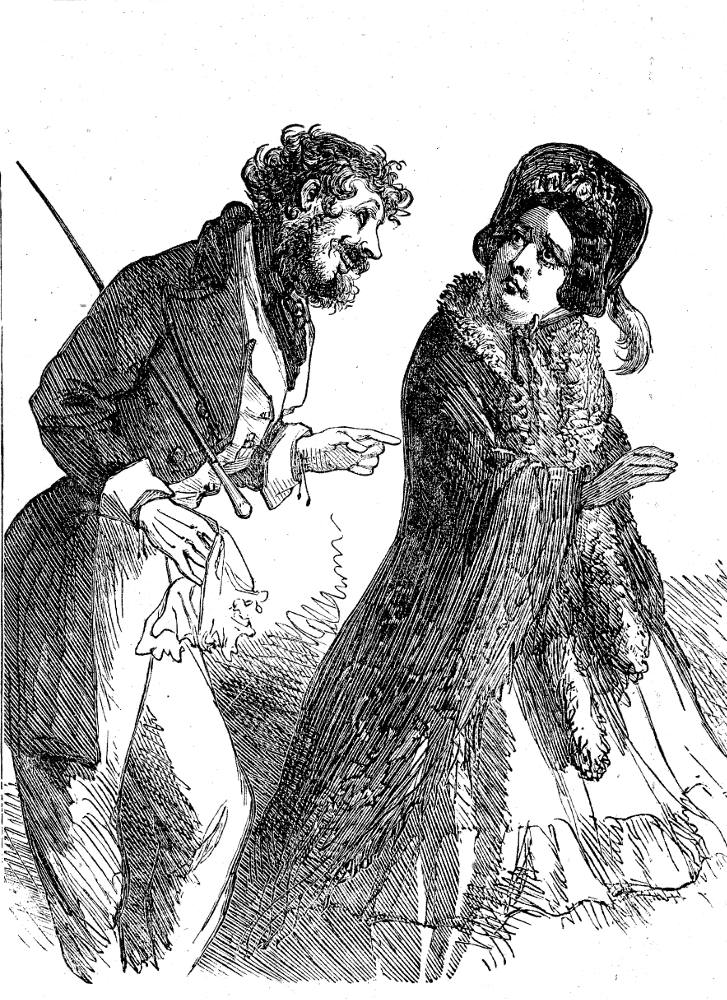"Mr. Alfred Mantalini" — Furniss's sixteenth illustration for Dickens's "Nicholas Nickleby" (1910) (original) (raw)
Passage Illustrated: Mantalini touches Ralph Nickleby for a loan
"There is quite a bloom upon your demd countenance," said Mr. Mantalini, seating himself unbidden, and arranging his hair and whiskers. "You look quite juvenile and jolly, demmit!"
"We are alone," returned Ralph, tartly. "What do you want with me?"
"Good!" cried Mr. Mantalini, displaying his teeth. "What did I want! Yes. Ha, ha! Very good. What did I want. Ha, ha. Oh dem!"
"What do you want, man?" demanded Ralph, sternly.
"Demnition discount," returned Mr. Mantalini, with a grin, and shaking his head waggishly.
"Money is scarce," said Ralph.
"Demd scarce, or I shouldn’t want it," interrupted Mr. Mantalini.
"The times are bad, and one scarcely knows whom to trust," continued Ralph. "I don’t want to do business just now, in fact I would rather not; but as you are a friend — how many bills have you there?"
"Two," returned Mr. Mantalini.
"What is the gross amount?"
"Demd trifling — five-and-seventy."
"And the dates?"
"Two months, and four." [Chapter XXXIV, "Wherein Mr. Ralph Nickleby is visited by Persons with whom the Reader has been already made acquainted," 434-435]
Commentary: A Dysfunctional Marriage
Although she is a highly competent businesswoman, Mayfair dressmaker Madame Mantalini often fails to see through her handsome, n'er-do-well foreign husband's blandishments. Alfred (Muntle) Mantalini, a wastral and a spendthrift, has become entangled in Ralph Nicklbey's financial snares, as his personal extravagances have resulted in his wife's business going into bankruptcy. Their arrival at Ralph Nickleby's counting-house to borrow money brings the unscrupulous money-lender good news: they recount how Nicholas has run into trouble as a result of his altercation with Sir Mulberry Hawk about his unwanted advances towards Kate. Furniss focuses on Mantalini's fashionable exterior as a reflection of his egotism, emphasizing his magnificent whiskers.
Illustrations of Mantalinis from Other Editions (1839, 1867, and 1875)
Left: Phiz's realizes the same scene, but includes Madame Mantalini: Mr. and Mrs. Mantalini in Ralph Nickleby's Office (February 1839), Chapter 11. Centre: Fred Barnard presents Mantalini's manipulative nature through his theatrically proposing suicide in the Household Edition: The dressing-room door being hastily flung open, Mr. Mantalini was disclosed to view, with his shirt collar symmetrically thrown back: putting a fine edge to a breakfast knife by means of his razor strop. (1875). Right: Sol Eytinge, Jr., presents the couple as a study in contrasts: Mr. and Madame Mantalini (1867).
Related material, including front matter and sketches, by other illustrators
- Nicholas Nickleby (homepage)
- Phiz's 38 monthly illustrations for the novel, April 1838-October 1839.
- Cover for monthly parts
- Charles Dickens by Daniel Maclise, engraved by Finden
- "Hush!" said Nicholas, laying his hand upon his shoulder. (Vol. 1, 1861)
- The Rehearsal (Vol. 2, 1861)
- "My son, sir, little Wackford. What do you think of him, sir?" (Vol. 3, 1861)
- Newman had caught up by the nozzle an old pair of bellows . . . (Vol. 4, 1861).
- Sol Eytinge, Jr.'s 16 illustrations for The Diamond Edition (1867)
- C. S. Reinhart's 52 Illustrations for the American Household Edution (1875)
- Fred Barnard's 59 Illustrations for the Household Edution (1877)
- Kyd's four Player's Cigarette Cards (1910).
Bibliography
Barnard, J. "Fred" (illustrator). Charles Dickens's Nicholas Nickleby, with fifty-eight illustrations. The Works of Charles Dickens: The Household Edition. 22 vols. London: Chapman and Hall, 1875. Volume 15. Rpt. 1890.
Bentley, Nicolas, Michael Slater, and Nina Burgis. The Dickens Index. Oxford and New York: Oxford U. P., 1988.
Davis, Paul. Charles Dickens A to Z: The Essential Reference to His Life and Work. New York: Facts On File, 1998.
Dickens, Charles. The Life and Adventures of Nicholas Nickleby. With fifty-two illustrations by C. S. Reinhart. The Household Edition. New York: Harper & Brothers, 1872. I.
__________. Nicholas Nickleby. With 39 illustrations by Hablot K. Browne ("Phiz"). London: Chapman & Hall, 1839.
__________. Nicholas Nickleby. Illustrated by Harry Furniss. The Charles Dickens Library Edition. 18 vols. London: Educational Book, 1910. IV.
__________. "Nicholas Nickleby." Scenes and Characters from the Works of Charles Dickens, being eight hundred and sixty-six drawings by Fred Barnard et al.. Household Edition. London: Chapman and Hall, 1908.
Created 20 April 2021


